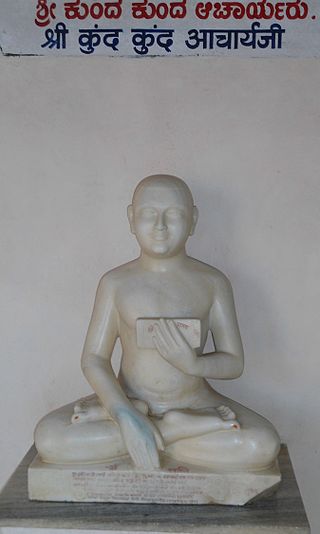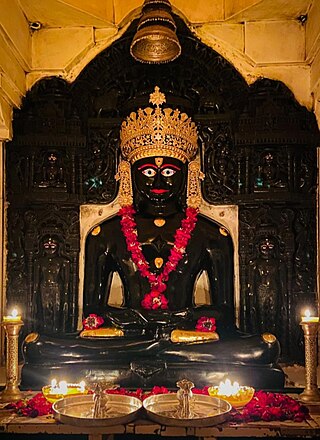
Mahavira, also known as Vardhamana, was the 24th Tirthankara of Jainism. He was the spiritual successor of the 23rd Tirthankara Parshvanatha. Mahavira was born in the early 6th century BCE to a royal Jain family of ancient India. His mother's name was Trishala and his father's name was Siddhartha. They were lay devotees of Parshvanatha. Mahavira abandoned all worldly possessions at the age of about 30 and left home in pursuit of spiritual awakening, becoming an ascetic. Mahavira practiced intense meditation and severe austerities for twelve and a half years, after which he attained Kevala Jnana (omniscience). He preached for 30 years and attained moksha (liberation) in the 6th century BCE, although the year varies by sect.

The Śvetāmbara is one of the two main branches of Jainism, the other being the Digambara. Śvetāmbara in Sanskrit means "white-clad", and refers to its ascetics' practice of wearing white clothes, which sets it apart from the Digambara or "sky-clad" Jains whose ascetic practitioners go nude. Śvetāmbaras do not believe that ascetics must practice nudity.

Samprati was the 5th Emperor of the Maurya empire. He was the son of 3rd Mauryan Emperor Ashoka's son, Kunala and succeeded his cousin, 4th Mauryan Emperor Dasharatha, as emperor of the Maurya Empire. He built 1,50,000 Jain Derasars and made 1,50,00,000 Jain idols. He was also believed to have taken an oath to dig the foundation of a new Jinalaya every day and would not do navakrashi until it was completed.

Parshvanatha, or Pārśva and Pārasanātha, was the 23rd of 24 Tirthankaras of Jainism. He gained the title of Kalīkālkalpataru.

Buddhism and Jainism are two Indian religions that developed in Magadha (Bihar) and continue to thrive in the modern age. Gautama Buddha and Mahavira are generally accepted as contemporaries. Jainism and Buddhism share many features, terminology and ethical principles, but emphasize them differently. Both are śramaṇa ascetic traditions that believe it is possible to attain liberation from the cycle of rebirths and deaths (samsara) through spiritual and ethical disciplines. They differ in some core doctrines such as those on asceticism, Middle Way versus Anekantavada, and self versus non-self.

Kundakunda was a Digambara Jain monk and philosopher, who likely lived in the second century CE or later.
Anekāntavāda is the Jain doctrine about metaphysical truths that emerged in ancient India. It states that the ultimate truth and reality is complex and has multiple aspects.

Mallinatha was the 19th tīrthaṅkara "ford-maker" of the present avasarpiṇī age in Jainism.

Nemināth, also known as Nemi and Ariṣṭanemi, is the twenty-second Tīrthaṅkar of Jainism in the present age. Neminath lived 81,000 years before the 23rd Tirthankar Parshvanath. According to traditional accounts, he was born to King Samudravijaya and Queen Shivadevi of the Yadu dynasty in the north Indian city of Sauripura. His birth date was the fifth day of Shravan Shukla of the Jain calendar. Krishna, who was the 9th and last Jain Vasudev, was his first cousin.
The Acharanga Sutra is the first of the twelve Angas, part of the agamas which were compiled based on the teachings of 24th Tirthankara Mahavira.
Siddhasēna Divākara was a Jain monk of the Śvetāmbara sect in the fifth century CE who wrote works on Jain philosophy and epistemology. He was like the illuminator of the Jain order and therefore came to be known as Divākara, "Sun". He is credited with the authorship of many books, most of which are not available. Sanmatitarka is the first major Jain work on logic written in Sanskrit. Among the most popular of his works, the Kalyan Mandir Stotra is a Sanskrit hymn dedicated to the 23rd Tirthankara Parshvanatha. It is one of the 9 holiest recitations in the Śvetāmbara Murtipujak sect of Jainism.
Jainism is a religion founded in ancient India. Jains trace their history through twenty-four tirthankara and revere Rishabhanatha as the first tirthankara. The last two tirthankara, the 23rd tirthankara Parshvanatha and the 24th tirthankara Mahavira are considered historical figures. According to Jain texts, the 22nd tirthankara Neminatha lived about 5,000 years ago and was the cousin of Krishna.

Jain literature refers to the literature of the Jain religion. It is a vast and ancient literary tradition, which was initially transmitted orally. The oldest surviving material is contained in the canonical Jain Agamas, which are written in Ardhamagadhi, a Prakrit language. Various commentaries were written on these canonical texts by later Jain monks. Later works were also written in other languages, like Sanskrit and Maharashtri Prakrit.

Gautama Swami, born as Indrabhuti Gautama was the first Ganadhara of Mahavira, the 24th and last Jain Tirthankara of present half cycle of time. He is also referred to as Guru Gautama, Gautama Ganadhara, and Ganadhara Gautama Swami.

Yashovijaya, a seventeenth-century Jain philosopher-monk, was a notable Indian philosopher and logician. He was a thinker, prolific writer and commentator who had a strong and lasting influence on Jainism. He was a disciple of Muni Nayavijaya in the lineage of Jain monk Hiravijaya who influenced the Mughal Emperor Akbar to give up eating meat. He is also known as Yashovijayji with honorifics like Mahopadhyaya or Upadhyaya or Gani.
According to the Jain cosmology, the Śalākāpuruṣa "illustrious or worthy persons" are 63 illustrious beings who appear during each half-time cycle. They are also known as the triṣaṣṭiśalākāpuruṣa. The Jain universal or legendary history is a compilation of the deeds of these illustrious persons. Their life stories are said to be most inspiring.

Digambara is one of the two major schools of Jainism, the other being Śvetāmbara (white-clad). The Sanskrit word Digambara means "sky-clad", referring to their traditional monastic practice of neither possessing nor wearing any clothes.

Jainism is an Indian religion which is traditionally believed to be propagated by twenty-four spiritual teachers known as tirthankara. Broadly, Jainism is divided into two major schools of thought, Digambara and Śvetāmbara. These are further divided into different sub-sects and traditions. While there are differences in practices, the core philosophy and main principles of each sect is the same.
Sivabhuti was a Jain monk in the 1st century AD who is regarded as the monk who started the Digambara tradition in 82 AD as per the 5th century Śvetāmbara text Avashyak Bhashya written by Jinabhadra. Little is known about him apart from a single story that is written in the ancient Śvetāmbara text. Among several works of research on Jainism, The Jains, a book by Paul Dundas mentions him and the story. However, historical authenticity of his existence or the truthfulness of the story has not been verified.












